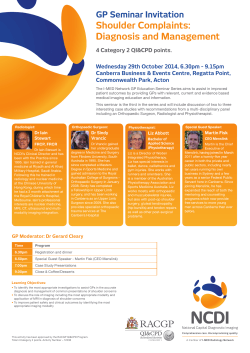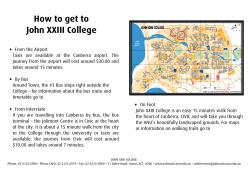
Comments on proposed Canberra Brickworks and
www.tinyurl/WalkACT To: Land Development Agency: brickworks@act.gov.au Comments on proposed Canberra Brickworks and Environs development Summary The proposed Canberra Brickworks and Environs development would appeal primarily to childless adults who would drive, cycle or walk to work in Deakin, drive or bus to work in Civic or Woden, or drive or cycle to work in Parkes. It would contribute little towards the ACT Government's 2012 election commitment of “increasing the public transport share of all work trips to 10.5% by 2016 and 16% by 2026,” or towards the walking or cycling targets in Transport for Canberra. These commitments and targets are shown in the following graph. Community and Recreation Facilities The proposed development will remove the existing playground and park between Thesiger Court and Adelaide Avenue. This is contrary to Section 3.2 of the Community and Recreation Facilities Location Guidelines General Code, which states that “ACT City Operations aims for residential areas to be within 400 metres of local parks with playground facilities”. Page 1 of 3 Walking and cycling within the development Walking and cycling paths should comply with Table 2A of the Estate Development Code1, rather than with the the lesser proposal in the Planning and Development Strategy that “Each major street type is granted its character through generous footpaths.” The development should include – or at least should not preclude – the most cost-effective of the 200 trunk walking and cycling projects that were evaluated in 2011 – a direct link between Thesiger Court and the Adelaide Avenue off-road shared path and on-road cycle lanes. 2 Access to shops Walking distances to the potential small scale shops near the brickworks would be up to 650 metres in the Yarralumla section of the development. This implies a round trip of more than fifteen minutes, even for a minor purchase such as a litre of milk. Round trip walking times from the Deakin section of the development will be up to 35 minutes. Walking times to a local shop would be significantly reduced if the shop were located near the centre of the development. Such a site would obtain greater benefit from the passing traffic of people travelling to and from the development. A shop near the brickworks is unlikely to be commercially viable due to the lack of through-traffic or major trip generators such as schools. The Deakin section of the precinct is about 1 km from the potential small scale shops near the brickworks, 1.1 km from the Yarralumla shops, and 1.5 km from the Deakin shops. The nearest major supermarket is 3.7 km away at the Curtin shops. This distance could be reduced to 3 km by a more direct shared path across Dunrossil Drive, the Cotter Road and the Yarralumla Creek. Walking or cycling to work or education In the absence of a patrolled school crossing on busy Novar Street, parents are unlikely to allow their children to walk or cycle to Yarralumla Primary School. Distances greater than 2km are a disincentive to walking, and distances over 5km are a disincentive to cycling. In Copenhagen, 23% of people who formerly cycled to work or education cite “too far to work” as their reason for no longer cycling to work or education. 44% of trips to work or education are on foot or by bicycle, but only one in six walks to work or education is more than 2 km, and only one third of cycles to work or education is more than 5 km.3 Yarralumla Primary School is 1.5 km from the development, Alfred Deakin High School 2 km, and Canberra College 4.5km. Woden Town Centre and the Phillip CIT are 5 km from the precinct, Civic is 6 km and the Australian National University is 7 km. 1 2 3 The Estate Development Code requires a path at least 1.5m wide on at least one side of each Access Street A, a 2.0m wide path on each Access Street B and a 2.5m wide path on each side of each Minor Collector Street. For more information on the Thesiger Court link, see http://grapevine.net.au/~mccluskeyarundell/LSNewsDec2014.html#__RefHeading__883_196466884 4 City of Copenhagen, 2010, Copenhagen City of Cyclists Bicycle Account 2010, p.23. http://velotraffic.com/wp-content/uploads/2011/07/bicycle-account-2010-copenhagen.pdf Page 2 of 3 Public transport Public transport access to and from the site is poor. A resident with an appointment 5 km away in the nearest Town Centre at Woden may need to leave home 90 minutes prior to the appointment. Public transport links to employment in Deakin, Parkes and Barton are poor. Bus frequency at the existing Novar St stop is about every 25 minutes in peak times, and hourly at other times. Walking time to this stop is up to 13 minutes. In-bus travel times to Woden range from 12 minutes (off peak) to 17 minutes in peak. In-bus travel times to Civic range from 21 minutes (off peak) to 24 minutes in peak. New bus stops near the intersection of the Cotter Road and the new Brickworks Road will improve bus access. A proposed bus stop in the median of Yamba Drive would provide access to intertown services at frequencies of 3 to 15 minutes. In-bus travel times to Woden would range from 6 to 9 minutes, and to Civic from 7 to 10 minutes. Walking to or from this bus stop will add up to 15 minutes to travel times. This stop is more than 1 km from some parts of the development. Safe access to this bus stop would require stairs and/or a lift from the centre of the bridge. Security issues would need to be addressed at this stop. Although there is potential surveillance from passing vehicles, there is no provision for drivers to stop and assist in the event of an emergency. Leon Arundell, B. Sc. Hons., M. Env. St., Grad. Dipl. Appl. Econ. Chair, Living Streets Canberra 4 April 2015 Page 3 of 3
© Copyright 2025











